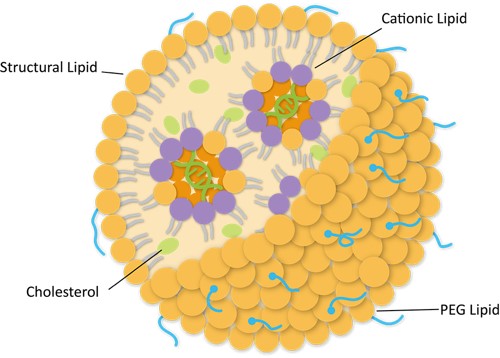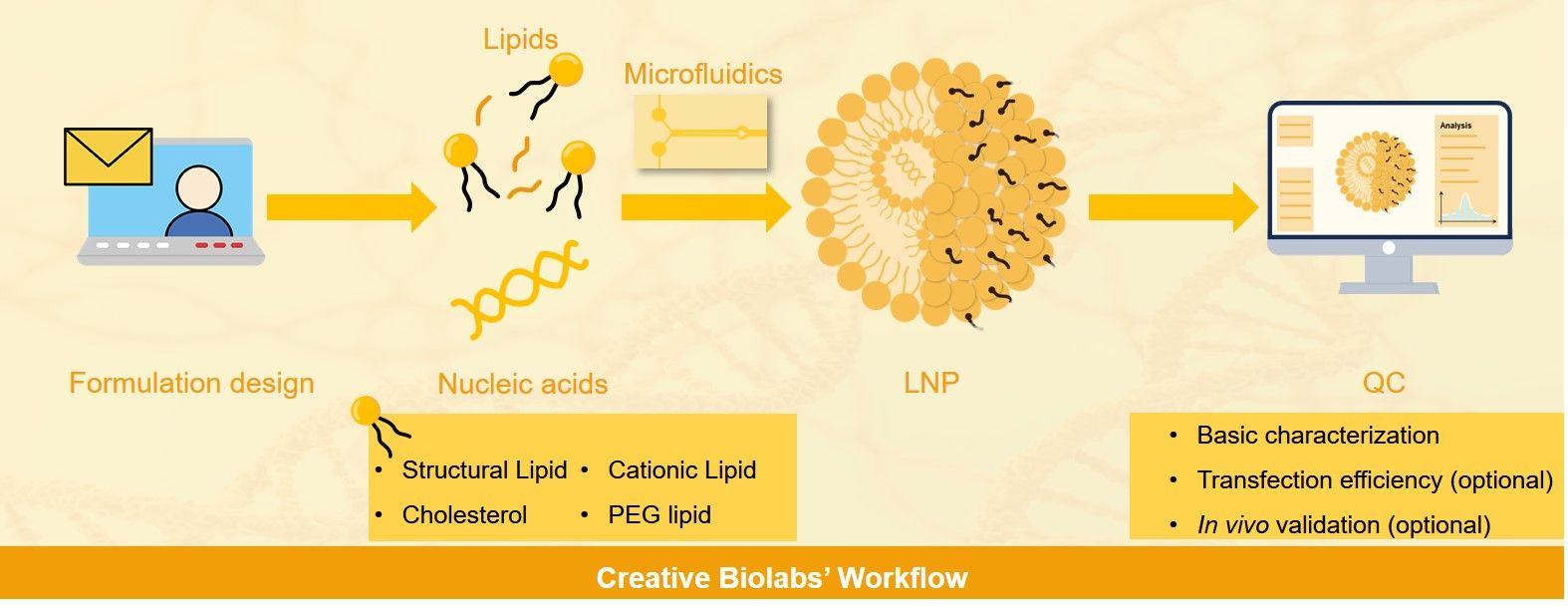With unrivaled transfection efficiency, Creative Biolabs' LNP services are designed to deliver your genetic material with precision. Our proprietary lipid formulations and advanced microfluidic technology ensure high encapsulation rates and uniform particle size distribution, which are paramount for reliable and consistent research outcomes. Our LNP platform ensures the precise and efficient delivery of genetic material to a spectrum of immune cell populations, such as macrophages, dendritic cells, NK cells, and T cells, among others. Our expertise extends to the entire mRNA development process, including design, manufacturing, formulation, encapsulation, validation, and the expansion of production scales.
Lipid nanoparticles (LNPs) represent a new class of spherical vesicles featuring a core-shell architecture. These nanoparticles typically incorporate an ionizable lipid component that carries a positive charge at low pH levels for complexing with RNA and becomes neutral at physiological pH, minimizing potential toxicity associated with cationic liposomes. Their unique properties and nanoscale dimensions (~100 nm) allow for cellular uptake through endocytosis, followed by cytoplasmic release of their contents via low pH-induced endosomal escape. As a result, LNPs offer enhanced benefits over conventional lipid carriers, such as superior nucleic acid encapsulation and transfection efficiency, enhanced penetration, and reduced cytotoxicity.
 Fig.1 Structure of lipid nanoparticle.
Fig.1 Structure of lipid nanoparticle.
Adjusting the proportions of various components within LNPs can influence their effectiveness, necessitating the customization of LNP formulations to accommodate specific pharmaceuticals, uses, and methods of administration.
 Fig.2 Creative Biolabs' LNP customization process.
Fig.2 Creative Biolabs' LNP customization process.
If you require customized LNPs, Creative Biolabs offers the option to include mRNA production in our services, ensuring a seamless and integrated solution for your specific needs. Our mRNA production services are tailored to your specifications, delivering precision and quality at every step of the LNP customization process.
 Fig.3 Creative Biolabs' mRNA production process.
Fig.3 Creative Biolabs' mRNA production process.
Our LNP customization service offers tailored solutions for encapsulating mRNA, siRNA, gRNA, and DNA. Utilizing a cutting-edge microfluidic platform and integrated IVT-mRNA and LNP synthesis services. We pride ourselves on high encapsulation efficiency, high transfection efficiency, and the ability to control uniform particle size with precision.
 Fig.4 Creative Biolabs' workflow.
Fig.4 Creative Biolabs' workflow.
Creative Biolabs' mRNA-LNP services ensure excellence through a comprehensive QC covering all aspects of LNP characterization.
| Sample | Project | Lead Time |
| Plasmid | Appearance | 1-2 weeks |
| Concentration | ||
| Purity | ||
| mRNA | Appearance | 1-2 weeks |
| Purity | ||
| Sequence verification | ||
| mRNA-LNP |
Basic characterization (Encapsulation efficiency, size, PDI, Zeta potential) |
1-2 weeks |
| Morphology | ||
| pH | ||
| RNA integrity (optional) | ||
| Endotoxin (optional) | ||
| Transfection efficiency (optional) | ||
| In vivo validation (optional) |
| Product Name | Lipid Composition | Application |
| ALC-0159 | PEG-N,N-ditetradecylacetamide | LNP |
| ALC-0315 | ((4-Hydroxybutyl)azanediyl)bis(hexane-6,1-diyl) bis(2-hexyldecanoate) | LNP |
| LNP Preparation Kit (SM102) | SM102, Cholesterol, DSPC, DMG-PEG (2000) | LNP |
| LNP Preparation Kit (DLin-MC3-DMA) | DLin-MC3-DMA, Cholesterol, DSPC, DMG-PEG (2000) | LNP |
| LNP Preparation Kit (ALC-0315) | ALC-0315, Cholesterol, DSPC, DMG-PEG (2000) | LNP |
| LNP Preparation Kit (cKK-E12) | cKK-E12, Cholesterol, DSPC, DMG-PEG (2000) | LNP |
Creative Biolabs, with over a decade of expertise in the field of lipid-based drug delivery systems, has been offering tailored solutions to our collaborators. Our team of liposome specialists has been deeply engaged in the development and refinement of LNP formulations, leveraging the cutting-edge LipoDrive™ technology to create a range of reliable LNP compositions and well-established manufacturing methods. If you're in search of an effective gene delivery vector or the optimal LNP formulation for your specific project, Creative Biolabs stands ready to assist you. Please contact us today to discuss your project.
 For Research Use Only. Not For Clinical Use
For Research Use Only. Not For Clinical UseServices
Online Inquiry

